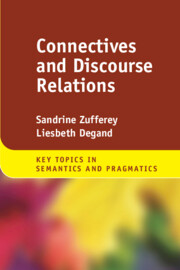Book contents
- Connectives and Discourse Relations
- Key Topics in Semantics and Pragmatics
- Connectives and Discourse Relations
- Copyright page
- Contents
- Figures
- Tables
- 1 Defining Connectives and Discourse Relations
- 2 Theoretical Models of Discourse Relations
- 3 Connectives: Meanings and Functions
- 4 Connectives between Syntax and Discourse
- 5 The Evolution of Connectives’ Meanings
- 6 Processing and Understanding Discourse Relations and Connectives
- 7 Discourse Relations and Connectives across Languages and Genres
- 8 Acquiring Connectives in a First Language
- 9 Mastering Connectives in a Second Language
- Conclusion
- Glossary
- References
- Index
- References
4 - Connectives between Syntax and Discourse
Published online by Cambridge University Press: 22 February 2024
- Connectives and Discourse Relations
- Key Topics in Semantics and Pragmatics
- Connectives and Discourse Relations
- Copyright page
- Contents
- Figures
- Tables
- 1 Defining Connectives and Discourse Relations
- 2 Theoretical Models of Discourse Relations
- 3 Connectives: Meanings and Functions
- 4 Connectives between Syntax and Discourse
- 5 The Evolution of Connectives’ Meanings
- 6 Processing and Understanding Discourse Relations and Connectives
- 7 Discourse Relations and Connectives across Languages and Genres
- 8 Acquiring Connectives in a First Language
- 9 Mastering Connectives in a Second Language
- Conclusion
- Glossary
- References
- Index
- References
Summary
This chapter provides an overview of studies that call on the syntactic features of connectives as a means to disambiguate their function and meaning. These syntactic features cover the morphosyntactic nature of discourse connectives as well as their syntagmatic distribution. On the basis of existing lexicons of discourse connectives, we first give an overview of the morphosyntactic distribution of discourse connectives in several European and non-European languages. We then address a number of studies that focus on the (semi-automatic) identification and annotation of discourse connectives in context. This is of particular interest in the field of natural language processing, but also in the field of contrastive linguistics, where it has been shown that syntactic categories, including those underlying the description of discourse connective uses, are not always cross-linguistically valid. The final section is devoted to the relationship between the syntagmatic position of discourse connectives and their meaning, which has given rise to numerous studies at the grammar-discourse interface highlighting the fuzzy boundary between discourse connectives and discourse markers.
Keywords
- Type
- Chapter
- Information
- Connectives and Discourse Relations , pp. 72 - 91Publisher: Cambridge University PressPrint publication year: 2024

